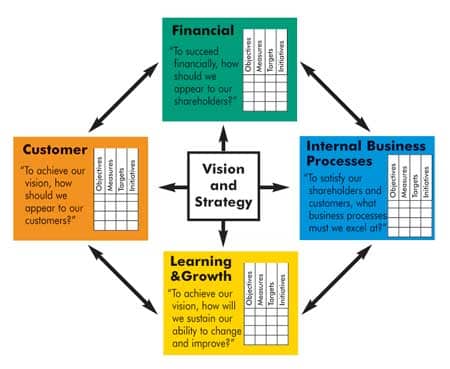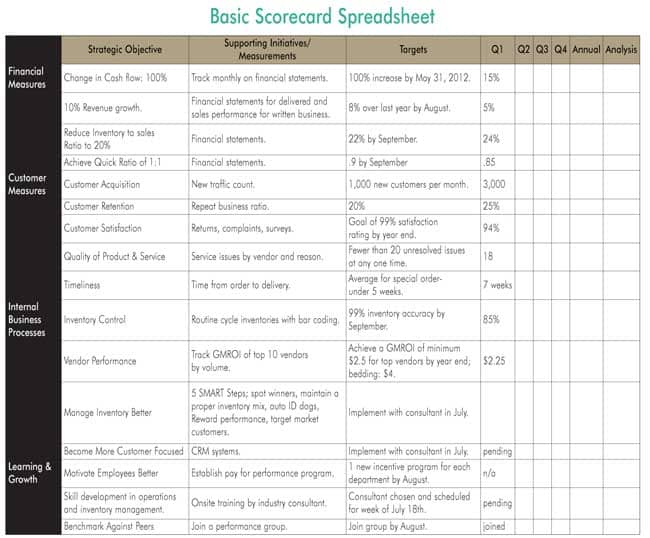The “Balanced Scorecard” identifies four Critical Success Factors (CSF’s) that drive performance.
Operations Success: by David McMahon
Answer this question and write down your answer: Specifically, where do you want your business to be one year from now?
Congratulations for answering! You have taken the first step on the path to getting there. I will now show you the next steps to take toward achieving your goal.
A key to achieving any goal is having a plan that includes measurable performance actions. Such a plan is your annual financial budget. The measurements can be described as performance reporting or a scorecard. This article is about how to use a performance scorecard as an organizational tool in your business.

What is a Scorecard?
A scorecard is used to measure the progress made toward achieving your goals. Those business people that do it properly have a significantly better chance of succeeding in their marketplace. Those that do not have usable reporting mechanisms generally rely on chance. Performance reporting and scorecards improve your odds of success.
The “Balanced Scorecard” was introduced by Drs. Robert Kaplan and David Norton to readers of the Harvard Business Review in the 1990s. The objective of the scorecard is to assist companies in achieving strategic objectives using both financial and non-financial measurements. In its design, the “Balanced Scorecard” identifies four Critical Success Factors (CSF’s) that drive performance: Financial, Customer, Internal Business Processes, and Learning and Growth. For each of these four performance factors, strategic objectives, measurements, targets, and initiatives are assigned.
Create a Performance Business Scorecard
There is no one size fits all. Your goals will be different from your peers even though you share the same industry and perhaps even the same market. You should consider your own strengths, weaknesses, opportunities, threats (SWOT). Be realistic. If you are weak in one area of your business, such as business processes, and strong in another area, such as customer service, realize this when designing your performance scorecard.
The following is an example of the process for creating a scorecard:
Overall Goal: This goes back to my initial question: “Where do you want to be one year from now?” Common answers to this question are often tied to sales or cash flow objectives. For this example let’s say that the overall goal is: To increase cash flow by 100% (double cash on hand while holding liabilities constant).
Financial Measures: This is where you can define the hard numbers that you wish to track. Seeing how the overall goal is to increase cash flow, we need to document the specific objectives and measures that will affect our goal. For this example we will use these strategic objectives: 10% revenue growth, 20% inventory to sales, 1:1 quick ratio. The associated measurements should be closely tracked on a monthly basis using your financial statements. If you wait to report on progress longer than a month, you may be too late to affect the desired result.
Customer Measures: To drive future performance, non-financial measures must be defined. Customer measures are the first. Common strategic objectives in this category are improvements in customer acquisition, customer retention, customer satisfaction, quality, and timeliness.
Customer acquisition involves increasing new customer counts. Retention is keeping existing customers coming back. Both objectives are key to short and long term growth. Improving satisfaction, product quality, and service is an initiative that sets the organization apart from competitors. Timeliness has the dual goal of delivering product quickly while speeding up the revenue cycle.
Through setting up systems that track and improve these customer related measures, the overall goal of increasing cash flow will be impacted. Sales should improve as well, the result of happier customers, increased traffic, and better close rates.
Internal Business Process Measures: Financial and Customer Critical Success Factors get the most attention from most independent businesses. The next two CSFs, Internal Business Process and Learning and Growth hold great opportunity as these factors could be better embraced by the home furnishings industry.
The purpose of developing strong internal business processes is to achieve the best results. Well defined policies and procedures allow people to operate at higher capacities. This success factor is a primary reason why businesses of the same sales volume can be at opposite ends of the spectrum on measures of cash flow and profitability. For the purpose of the example in the table on the previous page, the business processes that form the strategic objectives are: improving inventory control, increasing vendor performance, managing inventory better, becoming more customer-driven, and implementing a more effective Customer Relationship Management (CRM) system.
Internal business processes are necessary if you want to get positive movement in your financial and customer measures. I suggest getting a SWOT analysis or operational audit performed on your organization so you can see where you are lagging behind best practice operators. Then you can decide which business constraints you want to try to address first and which innovations you wish to embrace.
Learning and Growth Measures: The final critical success factor in this performance scorecard is learning and growth. You might have the greatest plan and the best computer system in the world but without a well trained and motivated team, goals become dreams. To make sure that does not happen, in this example, I’ve suggested the following strategic learning and growth activities:
- Implement a pay for performance system to bolster various measures in the scorecard.
- Develop skills in operational processes and inventory management.
- Improve the effectiveness of the sales manager.
To accomplish any of these objectives, you must look to internal and external resources for help. You may have leaders within your organization that will step up and champion a project if you give them the chance. You must also look to industry experts to act as catalysts for direction and training with respect to learning and growth. There is no successful organization that has “gotten there” alone.
The Performance Scorecard Illustrated

Take a look at the basic scorecard spreadsheet that is based on the graphic example at the start of this article. On a monthly and quarterly basis, assess your measures and adjust your strategy if necessary. Keep it dynamic. Add and delete items as necessary. Just be sure to always consider the four critical success factors and the important role they play in your business. Think of the scorecard as a master performance report with all other reports providing supporting information. This will help you focus on your primary goal and give you a greater chance of success.
OFFER:
In his last article for Furniture World, David McMahon gave away a break-even calculator to many of our readers. This time, he is offering the first 20 Furniture World readers that email him at davidm@furninfo.com, a complementary one hour consultation.
David McMahon is a Senior Business Consultant for PROFITconsulting, a division of PROFITsystems, Inc. David can be reached at davidm@furninfo.com.